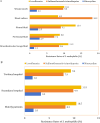Epidemiology and Antimicrobial Resistance of Stenotrophomonas maltophilia in China, 2014-2021
- PMID: 39731666
- PMCID: PMC11782787
- DOI: 10.1007/s40121-024-01099-7
Epidemiology and Antimicrobial Resistance of Stenotrophomonas maltophilia in China, 2014-2021
Abstract
Introduction: Stenotrophomonas maltophilia is an opportunistic pathogen associated with various nosocomial infections and is known for its intrinsic multidrug resistance. This study aims to provide a comprehensive overview of the epidemiology and resistance patterns of S. maltophilia in China from 2014 to 2021.
Methods: Data were extracted from the China Antimicrobial Resistance Surveillance System (CARSS) and the Blood Bacterial Resistance Investigation Collaborative System (BRICS), encompassing 1412 medical institutions across 31 provinces in China. We analyzed the prevalence of S. maltophilia in clinical isolates, focusing on specific patient populations and departments, as well as resistance profiles to recommended first-line antibiotics, including sulfamethoxazole-trimethoprim, levofloxacin, and minocycline.
Results: A total of 514,768 S. maltophilia strains were analyzed. The overall prevalence of S. maltophilia among all clinical bacterial isolates remained stable at approximately 2.1%, with higher rates observed in intensive care units and elderly patients. Resistance rates to sulfamethoxazole-trimethoprim decreased from 9.8% in 2014 to 7.5% in 2021. In contrast, resistance to levofloxacin showed a slight upward trend, increasing from 8.5% in 2014 to 9.5% in 2021. Meanwhile, minocycline resistance remained low, fluctuating marginally from 2.7% in 2014 to 1.7% in 2021.
Conclusions: This study highlights the stable prevalence of S. maltophilia in clinical settings in China and the overall low resistance rates to recommended first-line antibiotics. However, alarmingly high resistance rates were observed in specific specimen types, particularly in blood cultures, suggesting that minocycline may be the only reliable therapeutic option among the six tested antibiotics for treating such infections in China. Continuous surveillance and effective infection control measures are essential to manage S. maltophilia infections, particularly in vulnerable populations. Future research should focus on measuring the true burden of these infections and monitoring the susceptibility of the newly introduced antibiotics, such as cefiderocol.
Keywords: Stenotrophomonas maltophilia; Antimicrobial resistance; Epidemiology; Infection control; Nosocomial infections.
© 2024. The Author(s).
Conflict of interest statement
Declarations. Conflict of Interest: The authors (Hanli Wang, Shirong Li, Haoyu Ji, Yixin Hu, Susheng Zhou, Xingwu Chen, Zhiwei Lu, Qinghai You, Yusheng Cheng and Lei Zha) have no conflicts of interest to declare. Ethical Approval: This article is based on previously conducted studies and does not contain any new studies with human participants or animals performed by any of the authors. The study did not require approval because it utilized publicly available data.
Figures





Similar articles
-
Activity of Cefiderocol Alone and in Combination with Levofloxacin, Minocycline, Polymyxin B, or Trimethoprim-Sulfamethoxazole against Multidrug-Resistant Stenotrophomonas maltophilia.Antimicrob Agents Chemother. 2020 Aug 20;64(9):e00559-20. doi: 10.1128/AAC.00559-20. Print 2020 Aug 20. Antimicrob Agents Chemother. 2020. PMID: 32571820 Free PMC article.
-
Molecular epidemiology and risk factors of Stenotrophomonas maltophilia infections in a Chinese teaching hospital.BMC Microbiol. 2020 Sep 29;20(1):294. doi: 10.1186/s12866-020-01985-3. BMC Microbiol. 2020. PMID: 32993493 Free PMC article.
-
Relationship between antibiotic resistance with class 1 integron and SmeDEF efflux pump encoding genes in clinical isolates of Stenotrophomonas maltophilia.J Appl Genet. 2023 Sep;64(3):591-597. doi: 10.1007/s13353-023-00776-6. Epub 2023 Aug 14. J Appl Genet. 2023. PMID: 37574492
-
Steno-sphere: Navigating the enigmatic world of emerging multidrug-resistant Stenotrophomonas maltophilia.Pharmacotherapy. 2023 Aug;43(8):833-846. doi: 10.1002/phar.2828. Epub 2023 Jun 8. Pharmacotherapy. 2023. PMID: 37199104 Review.
-
Emerging infections in vulnerable hosts: Stenotrophomonas maltophilia and Elizabethkingia anophelis.Curr Opin Infect Dis. 2023 Dec 1;36(6):481-494. doi: 10.1097/QCO.0000000000000953. Epub 2023 Aug 2. Curr Opin Infect Dis. 2023. PMID: 37548375
References
-
- Arthur C, Tang X, Romero JR, Gossett JG, Harik N, Prodhan P. Stenotrophomonas maltophilia infection among young children in a cardiac intensive care unit: a single institution experience. Pediatr Cardiol. 2015;36(3):509–15. 10.1007/s00246-014-1041-0. - PubMed
-
- Gales AC, Castanheira M, Jones RN, Sader HS. Antimicrobial resistance among gram-negative bacilli isolated from Latin America: results from SENTRY antimicrobial surveillance program (Latin America, 2008–2010). Diagn Microbiol Infect Dis. 2012;73(4):354–60. 10.1016/j.diagmicrobio.2012.04.007. - PubMed
-
- Gales AC, Seifert H, Gur D, Castanheira M, Jones RN, Sader HS. Antimicrobial susceptibility of acinetobacter calcoaceticus-Acinetobacterbaumannii COMPLEX and Stenotrophomonas maltophilia clinical isolates: results from the SENTRY antimicrobial surveillance program (1997–2016). Open Forum Infect Dis. 2019;6(Suppl 1):S34-s46. 10.1093/ofid/ofy293. - PMC - PubMed
-
- Hu F, Guo Y, Zhu DM. CHINET surveillance of bacterial resistance: results of 2020. Chin J Infect Chemother. 2021;21(04):377–87. 10.16718/j.1009-7708.2021.04.001.
Grants and funding
LinkOut - more resources
Full Text Sources

